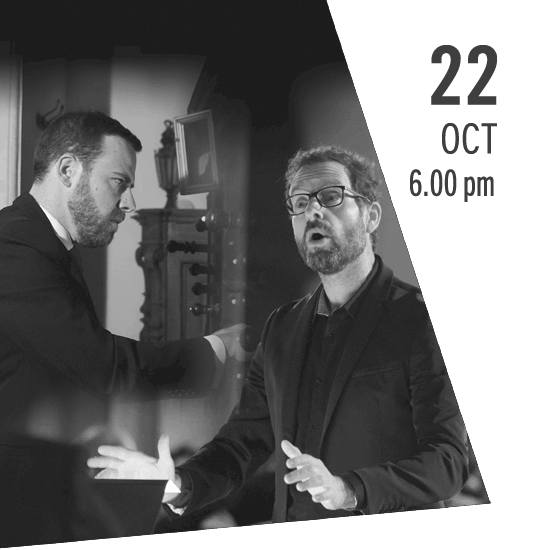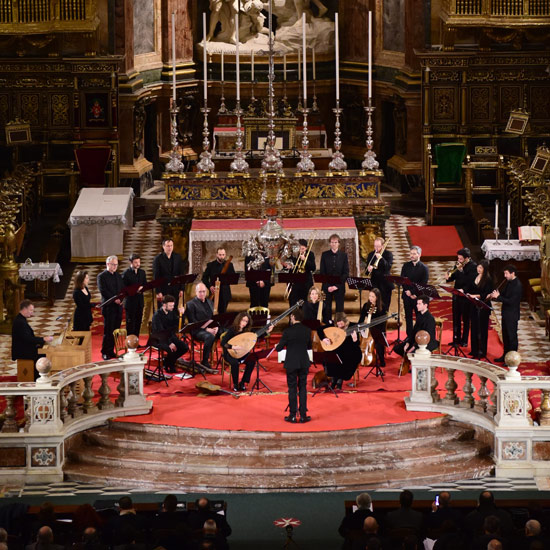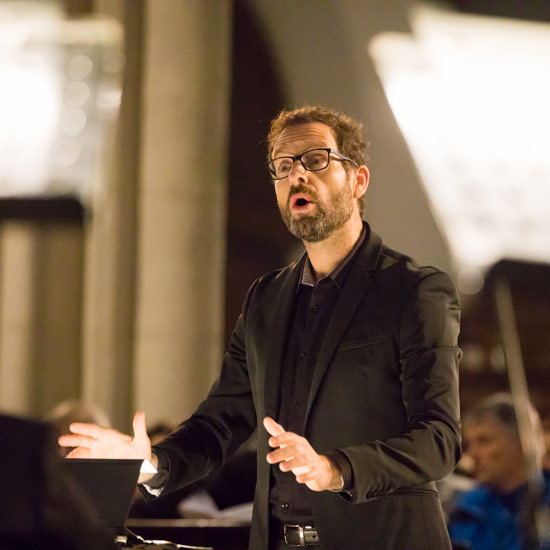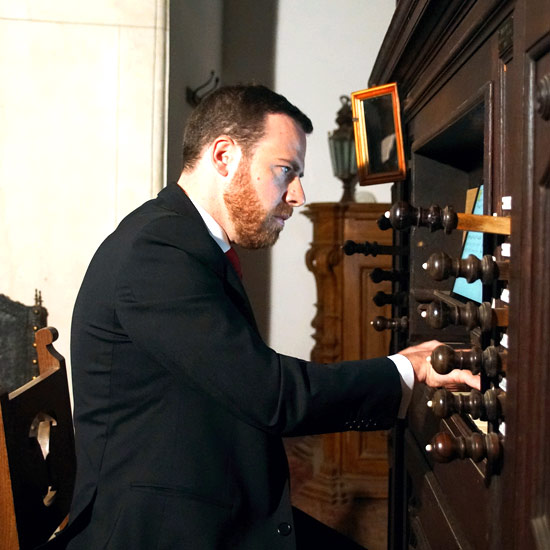 October 22, Sunday, 6.00 pm;
October 22, Sunday, 6.00 pm;
Igreja e Convento de Santa Clara · Funchal;
MAGNIFICAT The legacy of Aguilera de Heredia
Sérgio Silva, organ;
La Grande Chapelle;
Albert Recasens, direction;
The 16th and 17th centuries constitute the Centuries of glory of Spanish culture. However, the period 1580-1640 is where we find in most concentrated form the effervescence which the letters and arts in the Iberian Peninsula enjoyed. Names such as Cervantes, Lope de Vega, Góngora, Calderón de la Barca, Herrera, Velázquez, Zurbarán, Ribera and Gracián signal the cultural apogee of a period, that of the Spanish monarchy, which paradoxically contrasts with political decadence and an enormous economic crisis. These five prodigious decades coincide with the Philippine dynasty, the dynastic union between Spain and Portugal. Indeed, both countries shared a fruitful common artistic and cultural period, which gave rise, together with Italy, to the beginning of the Modern Era throughout Europe, where a new conception of the world would place the individual at the centre of everything. This flourishing also occurred in the musical field, with great masters of polyphony such as Tomás Luis de Victoria, Alonso Lobo and Mateo Romero in Spain, or Manoel Machado, Manoel Cardoso and Duarte Lobo in Portugal, who introduced the baroque style – that of polychorality, of accompanied monody and expressivity – in the Peninsula. One of the principal objectives of La Grande Chapelle was, precisely, to recover from oblivion these extraordinary musicians who served in cathedrals and palaces on both sides of the Atlantic. After some twenty discs and tens of first performances, Sebastián Aguilera de Heredia (1561-1627) was awaiting his turn, on account of his historical importace and musical quality. Aguilera is one of the most important composers of organ music of the Iberian Peninsula. His eighteen surviving works – tientos, Salves, hymns and “discourses” – make up an extraordinary legacy, given that, on the basis of the tradition of Cabezón and Santa María, he introduced stylistic innovations which would serve as a model for Cabanilles, Correa de Arauxo, Rodrigues Coelho, Ximénez and Bruna. The melodic imagination, sober style and cadential formulas of Aguilera are equal to those of Seixas or Soler, in the 18th century. Aguilera de Heredia probably studied with Melchor Robledo and Juan Oriz at the Cathedral of La Seo in Zaragoza, his native city. He was ordained a clergyman and, in 1585, appointed organist of the Cathedral of Huesca. After the death of Juan Oriz, in 1603, he became the principal organist of Le Seo, a position he occupied until his death. Both in Huesca and Zaragoza, Aguilera supervised the construction or repair of organs, into which he introduced half-registers, a crucial technical element for the new style (works for “split register”). As well as his his famous pieces for organ, Agilera was a composer of vocal music. His book Canticum Beatissimae Virginis deiparae Mariae, from 1618, was very widely disseminated. It consists of a collection of thirty-eight settings of the Magnificat – something extraordinary for the time – written for four, five, six and eight voices, that is, four cycles, each containing eight versions, one for each tone. Aguiler conceived various series of the Canticle of the Virgin for liturgical use at the office of Vespers of different feasts. They are true feats of counterpoint, in which Aguilera treats the psalmodic tones as cantus firmus and, like his organ works, uses false relations and daring dissonances. The programme which we are honoured to give for the first time at the Madeira International Organ Festival, thanks to their generous invitation and their interest in lesser-known repertoires, brings together a series of these Magificats. These vocal pieces will be heard again, together with some of the most brilliant works by Aguilera de Heredia or some verses by Manuel Rodrigues Coelho, whose book Flores de musica pera o instrumento de tecla & harpa (1620) dates from only two years later than the Canticum by Aguilera and is dedicated to Phillip II of Portugal and III of Spain.
Albert Recasens
Program:
SEBASTIÁN AGUILERA DE HEREDIA (c.1561-1627)
Magnificat primi toni, a 8
Magnificat quarti toni, a 8
alternated with
PLAINCHANT
Quartus tonus
Salve de primer tono por de la sol re
Magnificat septimi toni, a 4
alternated with
PLAINCHANT
Septimus tonus
and
MANUEL RODRIGUES COELHO (c.1555-c.1635)
Versos do 7º tom
Magnificat primi toni, a 8
alternated with
PLAINCHANT
Quartus tonus
Tiento de cuarto tono
Magnificat secundi toni, a 6
alternated with
PLAINCHANT
Secundus tonus
and
MANUEL RODRIGUES COELHO
Versos do 2º tom
Obra de octavo tono alto. Ensalada
Magnificat octavi toni, a 8
La Grande Chapelle
Axelle Bernage, cantus
Irene Mas Salom, cantus
David Sagastume, altus
Andrea Gavagnin, altus
Achim Schulz, tenor
Frederico Projecto, tenor
Gabriele Lombardi, bassus
Marcus Schmidl, bassus
Marta Vicente, violone
Sérgio Silva, organ
Albert Recasens, direction
 La Grande Chapelle
La Grande Chapelle
La Grande Chapelle is a vocal and instrumental early music ensemble with a European outlook whose main objective is to apply new readings to the great vocal works of the 16th to 18th centuries with special emphasis on the polychoral output of the Baroque period. At the same time it aims to contribute to the urgent task of reviving forgotten works from the Spanish musical repertoire. La Grande Chapelle has taken part in the most important Spanish music concert series and performed at some of the most prestigious Early Music festivals. Upon its foundation in 2005, fired by a desire to spread Spain’s musical heritage, La Grande Chapelle set up its own independent record label, Lauda, which specializes in recordings of great musical and musicological interest. It has focused on two principal areas: an exploration of the relationship between the music and literature of the Spanish Golden Age and the revival of works by the most outstanding Spanish renaissance and baroque composers through first-time recordings, particularly those that set a particular work or composer within a specific context. Recordings by La Grande Chapelle on the Lauda label have received several prestigious national and international awards and prizes for their quality and artistic rigour, including two “Orphées d’Or” (Académie du Disque Lyrique, Paris, in 2007 and 2009), “Label of the Year” in the “Prelude Classical Music Awards 2007” (The Netherlands), “5 of Diapason”, “Excepcional” in the magazine Scherzo, “Preis der deutschen Schallplattenkritik” (PdSK) - and the “Editor's Choice” and “Critic’s Choice” in the celebrated British magazine Gramophone.
 Albert Recasens
Albert Recasens
Upon finishing his music studies in Tarragona, Barcelona, Bruges and Ghent he took a degree in musicology at the Catholic University of Louvain where he graduated with a PhD on 18th-century stage music in Madrid. Since the beginning of his career he has combined performance, management and musicological research with the conviction that an interdisciplinary approach and total commitment are necessary for the promotion of forgotten musical heritage. He has published musicological studies in various journals and encyclopaedias, both nationally and abroad, and has been involved in different research projects (UAM, UB). His musical recovery project “Pedro Ruimonte in Brussels” was a beneficiary of a BBVA Awards Foundation grant for Researchers and Cultural Creators in 2016. In 2005 he began an ambitious project for the recovery of forgotten or overlooked Spanish music with the founding of La Grande Chapelle and the Lauda record label. This brought to light unreleased works from some of the great composers of the 17th and 18th centuries, in the form of premieres or first-time recordings. In 2007 he took over the reins as artistic director of La Grande Chapelle. Since then he has conducted numerous concerts of both polyphony and baroque music. Since September 2019 he has been a researcher at the Institute for Culture and Society (ICS) of the Universidad de Navarra.
 Sérgio Silva
Sérgio Silva
Holding a masters degree from the University of Évora, Sérgio Silva began studying organ at the Gregorian Institute of Lisbon under João Vaz, and accompaniment and improvisation under António Esteireiro. In addition, he had the opportunity to work with a number of organists of international renown, such as José Luis González Uriol, Luigi Ferdinando Tagliavini, Jan Willem Jansen, Michel Bouvard, Kristian Olesen and Hans-Ola Ericsson. As a concert performer, he appears regularly both as a soloist and a member in a number of prestigious Portuguese ensembles, and has performed in Portugal, Spain, Italy. Great Britain, France, Germany and Macau. As a researcher, he has made a number of transcriptions of early Portuguese music. He currently teaches organ at the Gregorian Institute of Lisbon and at the Lisbon School of Sacred Music, and is titular organist of the Basilica of Estrela and of the Church of St Nicholas in Lisbon.
